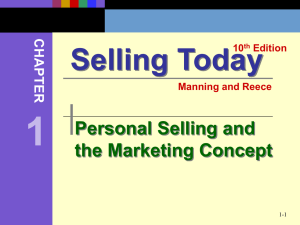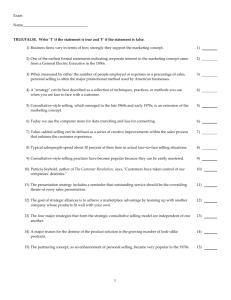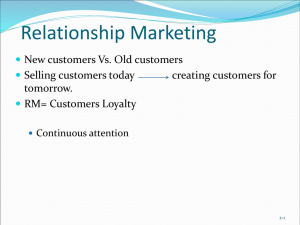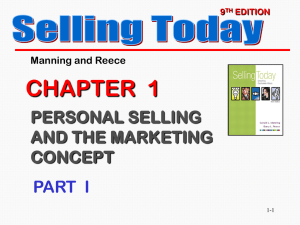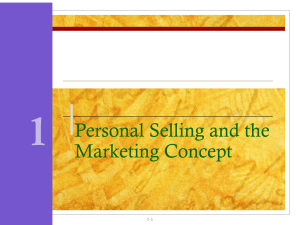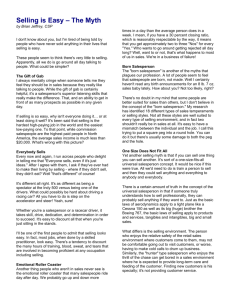free sample here
advertisement
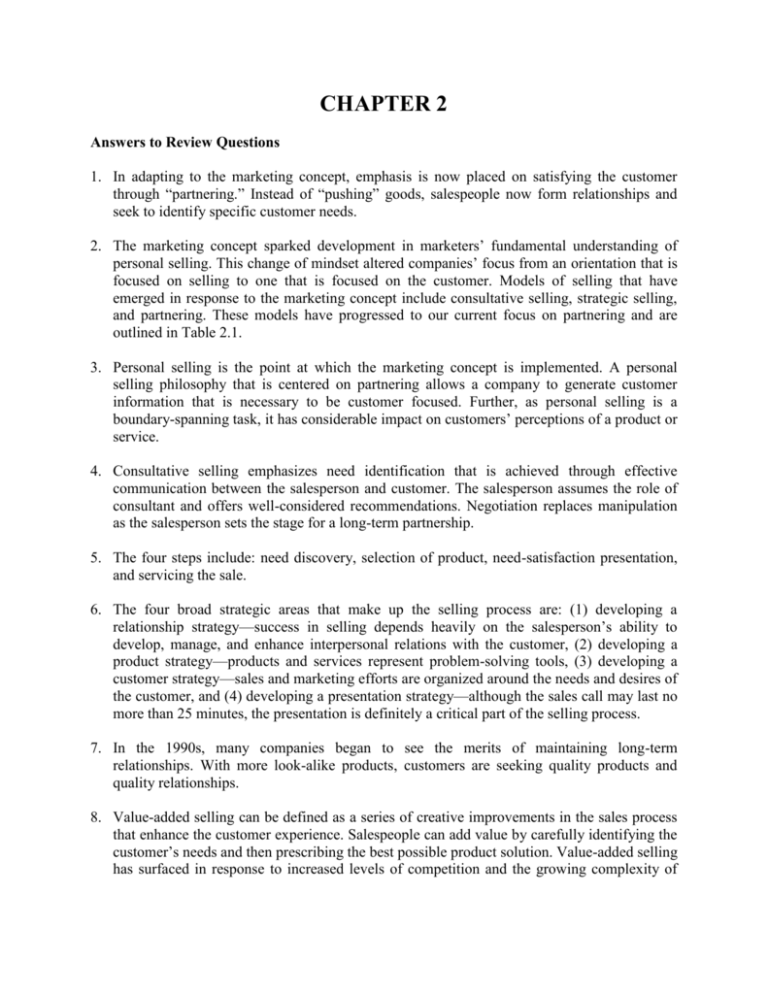
CHAPTER 2 Answers to Review Questions 1. In adapting to the marketing concept, emphasis is now placed on satisfying the customer through “partnering.” Instead of “pushing” goods, salespeople now form relationships and seek to identify specific customer needs. 2. The marketing concept sparked development in marketers’ fundamental understanding of personal selling. This change of mindset altered companies’ focus from an orientation that is focused on selling to one that is focused on the customer. Models of selling that have emerged in response to the marketing concept include consultative selling, strategic selling, and partnering. These models have progressed to our current focus on partnering and are outlined in Table 2.1. 3. Personal selling is the point at which the marketing concept is implemented. A personal selling philosophy that is centered on partnering allows a company to generate customer information that is necessary to be customer focused. Further, as personal selling is a boundary-spanning task, it has considerable impact on customers’ perceptions of a product or service. 4. Consultative selling emphasizes need identification that is achieved through effective communication between the salesperson and customer. The salesperson assumes the role of consultant and offers well-considered recommendations. Negotiation replaces manipulation as the salesperson sets the stage for a long-term partnership. 5. The four steps include: need discovery, selection of product, need-satisfaction presentation, and servicing the sale. 6. The four broad strategic areas that make up the selling process are: (1) developing a relationship strategy—success in selling depends heavily on the salesperson’s ability to develop, manage, and enhance interpersonal relations with the customer, (2) developing a product strategy—products and services represent problem-solving tools, (3) developing a customer strategy—sales and marketing efforts are organized around the needs and desires of the customer, and (4) developing a presentation strategy—although the sales call may last no more than 25 minutes, the presentation is definitely a critical part of the selling process. 7. In the 1990s, many companies began to see the merits of maintaining long-term relationships. With more look-alike products, customers are seeking quality products and quality relationships. 8. Value-added selling can be defined as a series of creative improvements in the sales process that enhance the customer experience. Salespeople can add value by carefully identifying the customer’s needs and then prescribing the best possible product solution. Value-added selling has surfaced in response to increased levels of competition and the growing complexity of many products and services. The value added by salespeople today is increasingly derived from intangibles such as the quality of the advice offered. 9. The goal of strategic selling alliances is to achieve a marketplace advantage by teaming up with another company whose products or services fit well with your own. Both companies hope to achieve a mutual competitive advantage. 10. Because salespeople are a vital link between a company and its customers, buyers will usually form impressions about the company based on the salesperson. Suggestions/Answers for Application Exercises 1. The outline should include the following topics: Economic benefits—development of global markets; stimulate our local economy, which reduces unemployment. Consumer benefits— assistance with the purchase of complex products; service after the sale. 2. She will have to: (1) research the kind of customer her product appeals to as well as the customer’s motivation for purchasing the product; (2) improve the product by engineering product features that will appeal to the customer; (3) package and brand it so it will be convenient and memorable to the customer; (4) price the product so it will be within the economic means of the customer and yet allow the company to make a reasonable profit; (5) select dealers and physically transport and store the product so it will be available in the right place at the right time; and (6) promote the sale of the product by communicating to the consumer through the mediums of personal selling, advertising, and other forms of sales promotion. 3. In teaching and selling, Sharon must be able to present scientific ideas accurately and persuasively. She must be able to motivate others as well as enjoy working with people. The differences consist of working without a prearranged schedule; she will need to organize her own time in sales work. Compensation plans, especially extra financial incentive, are usually found in selling; they are not usually found in teaching. 4. Students will find information regarding sales training offered by the company. Have them print and submit this information. Likely similarities that students will mention are partnering, win-win exchanges, problem solving, understanding the customer’s business, value-added selling, adaptive selling, and others. Role-Play Exercise Provide students with a brief introduction to the wide variety of pens and pencils available. A nice gold pen, for example, might sell for $100 or more. Solution for the Case Problem 1. Yes, it appears that Smith has adopted the three prescriptions of a personal selling philosophy. He demonstrates adoption of the marketing concept because he is constantly seeking to offer his customers the best value. He appears to value personal selling because he participates in a high degree of ongoing training. He also approaches selling as a problem solver because he bundles insurance policies that are in the customer’s best interest and works with all individuals who directly or indirectly influence the sale. 2. Smith has adopted the win-win philosophy; projects a professional image; and maintains high ethical standards. See page 36 for a description of why a relationship strategy is especially important in personal selling. 3. Smith can create value for his customers by helping them understand complicated insurance terms, comparing terms across policies (and even competitors), bundling policies to save the customer money, providing information about new policy types, and quantifying the benefit of having a particular insurance policy or the risk of not having a particular insurance policy. 4. It is imperative that Liberty Mutual employees in the marketing research and advertising departments understand personal selling because of the cross-functional demands placed on the marketing discipline. That is why Smith regularly communicates with employees in other departments – to understand the highly competitive insurance industry and to share market knowledge with them. Marketing support people in the departments mentioned in the question would all benefit from acquiring personal selling skills due to their interaction with stakeholders of the organization that are external to Liberty Mutual.

